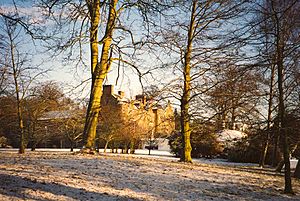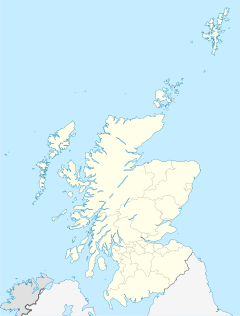Tealing facts for kids
Quick facts for kids TealingTèalainn |
|
|---|---|
 Balmuir House, 18th century with Victorian additions |
|
| OS grid reference | NO408383 |
| Council area | |
| Lieutenancy area | |
| Country | Scotland |
| Sovereign state | United Kingdom |
| Post town | DUNDEE |
| Postcode district | DD4 |
| Dialling code | 01382 |
| Ambulance | Scottish |
| EU Parliament | Scotland |
| UK Parliament |
|
| Scottish Parliament |
|
Tealing (which in Scottish Gaelic is called Tèalainn) is a small village. It is located in Angus, in eastern Scotland. You can find it at the bottom of the Sidlaw Hills. Tealing is only about 6 miles (10 km) north of the city of Dundee. It is also about 8 miles (13 km) south of Forfar.
Around 700 people live in Tealing, spread across 347 homes. The village covers about 15 square miles (39 km²) of good farming land. You'll see many large farms here, mixed with family homes. Many people living in Tealing travel to work in Dundee or other parts of Angus.
Tealing has an old stone primary school that is still very active. About 50 students attend the school. There is also a nursery school on the same site for younger children.
Even though Tealing looks very peaceful today, it has a long and exciting history. Its past includes early settlements, ancient carvings, and the Picts. It also saw religious changes, secrets from World War II, and big changes in farming. The community has always found ways to survive and thrive.
Contents
Tealing's Ancient Past and Early Churches
Long ago, around 100 AD, there was an early settlement of the Picts in Tealing. The Picts were an ancient people who lived in Scotland. Evidence of their homes can be seen near a place called the Tealing Earth-house. This was an underground building.
The first church in Tealing was built in 710 AD. It was founded by St Boniface. He was a missionary who started many churches in northeast Scotland.
Later, in 1728, a minister named John Glas from Tealing Parish Church was suspended. He then started a new church group called the Glasites. This group broke away from the main church.
After almost 1,300 years, local church services in Tealing ended in 1982. The Tealing Church joined with the Murroes church. The old church building still stands today. Its small graveyard is still used and has graves from the 1600s.
Tealing Airfield: A Secret During World War II
During the Second World War, something very important happened in Tealing. In 1942, the Ministry of Defence built an aerodrome here. An aerodrome is like a small airport. This airfield was also used as a Prisoner of War camp during the war.
The No. 56 Officer Training Unit opened at the airfield in March 1942. Pilots trained there using planes like the Hurricane and Master. In 1942, about 35 to 40 pilots were training. This number grew to 150 pilots in 1943.
A Famous Visitor to Tealing Airfield
Tealing Airfield had a very famous visitor during the war. On May 20, 1942, a unique four-engine plane landed there. It was flown by Endel Puusepp. This was one of the first Russian TB7s to visit Britain.
The plane brought Vyacheslav Molotov to Tealing. Molotov was a very important person. He was the Russian Foreign Minister and a top leader in the Soviet Union. He was on a secret mission to meet Sir Winston Churchill. Churchill was the Prime Minister of the United Kingdom at the time. They were meeting at a place called Chequers.
Tealing airfield was likely chosen for this secret meeting because it was quiet. It would not attract much attention. For safety reasons, there was no news about this visit at the time.
Molotov had a choice of two planes to continue his journey to England. He chose one, and the other plane crashed. This was later shared by Sir Archibald Philip Hope. The crash happened in the Vale of York. Sadly, some of Molotov's staff and important RAF officers died in that crash. Molotov arrived safely in London. There, he signed the Anglo-Soviet Treaty on May 26, 1942. This treaty was an important agreement between Britain and the Soviet Union.
Sir William Stewart Duke-Elder: A Visionary Doctor
Sir William Stewart Duke-Elder was born in Tealing on April 22, 1898. His father, Reverend Neil Elder, was the minister of the Tealing Free Church.
Duke-Elder became a very important doctor. He was a leading expert in ophthalmology. This is the study and treatment of eye diseases. He was a major figure in this field for over 25 years, both in Britain and around the world.
In 1932, he performed surgery on the Prime Minister at the time, Ramsay MacDonald. The surgery was for an eye condition called glaucoma. Duke-Elder was knighted in 1933. This means he was given the title "Sir" by the King. He received many more honors after that. He served as the eye doctor to three monarchs: King Edward VIII, George VI, and Queen Elizabeth II.
People who knew him described him as a kind and friendly Scottish man. He had a charming smile and a playful sense of humor. He made people feel comfortable right away.


